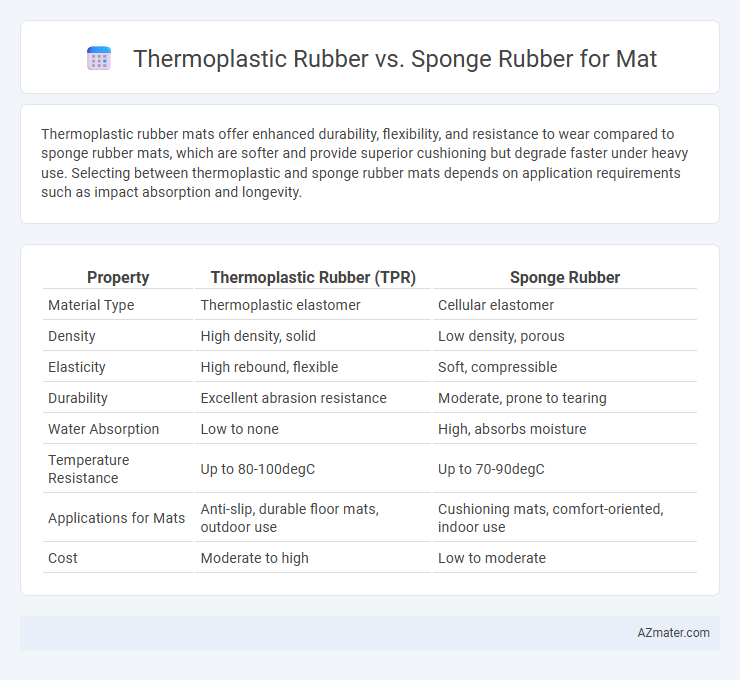Thermoplastic rubber mats offer enhanced durability, flexibility, and resistance to wear compared to sponge rubber mats, which are softer and provide superior cushioning but degrade faster under heavy use. Selecting between thermoplastic and sponge rubber mats depends on application requirements such as impact absorption and longevity.
Table of Comparison
| Property | Thermoplastic Rubber (TPR) | Sponge Rubber |
|---|---|---|
| Material Type | Thermoplastic elastomer | Cellular elastomer |
| Density | High density, solid | Low density, porous |
| Elasticity | High rebound, flexible | Soft, compressible |
| Durability | Excellent abrasion resistance | Moderate, prone to tearing |
| Water Absorption | Low to none | High, absorbs moisture |
| Temperature Resistance | Up to 80-100degC | Up to 70-90degC |
| Applications for Mats | Anti-slip, durable floor mats, outdoor use | Cushioning mats, comfort-oriented, indoor use |
| Cost | Moderate to high | Low to moderate |
Introduction to Thermoplastic Rubber and Sponge Rubber Mats
Thermoplastic rubber (TPR) mats combine the flexibility of rubber with the recyclability of thermoplastics, offering excellent durability, resistance to abrasion, and ease of cleaning, ideal for high-traffic areas. Sponge rubber mats feature a soft, porous structure made from natural or synthetic rubber foam, providing superior cushioning, slip resistance, and sound absorption, making them suitable for comfort and safety applications. Both materials serve distinct purposes in mat manufacturing, with TPR favored for toughness and environmental benefits and sponge rubber prized for comfort and impact absorption.
Composition and Material Properties
Thermoplastic rubber (TPR) mats consist of a blend of polymers and rubber with properties of both plastic and elastomers, offering flexibility, durability, and resistance to abrasion and chemicals. Sponge rubber mats are made from natural or synthetic rubber foamed with gas bubbles, resulting in a soft, lightweight material with excellent cushioning and shock absorption but lower abrasion resistance. TPR provides superior tensile strength and weather resistance, while sponge rubber excels in insulation and comfort due to its porous structure.
Durability and Longevity
Thermoplastic rubber (TPR) mats exhibit superior durability and longevity due to their resistance to wear, abrasion, and environmental factors like UV exposure and chemicals. Sponge rubber mats, while offering excellent cushioning and flexibility, tend to degrade faster under heavy use and prolonged exposure to moisture and temperature fluctuations. Selecting TPR mats ensures enhanced lifespan and sustained performance in high-traffic or demanding conditions.
Comfort and Cushioning
Thermoplastic rubber (TPR) mats provide superior comfort through their flexible yet durable composition, offering excellent shock absorption and long-lasting cushioning ideal for high-traffic areas. Sponge rubber mats excel in plushness, utilizing a cellular structure that enhances softness and provides a cozy, cushioned feel perfect for reducing foot fatigue in standing work environments. Both materials deliver effective cushioning, but TPR typically outperforms sponge rubber in resilience and maintaining comfort over extended use.
Slip Resistance and Safety Features
Thermoplastic rubber mats offer superior slip resistance due to their enhanced grip and abrasion resistance, making them ideal for high-traffic areas requiring safety assurance. Sponge rubber mats provide excellent cushioning and shock absorption but may have lower slip resistance compared to thermoplastic variants. Safety features in thermoplastic rubber include durability under wet conditions and resistance to oils, while sponge rubber excels in comfort and impact protection but may need additional anti-slip treatments.
Ease of Cleaning and Maintenance
Thermoplastic rubber mats offer superior ease of cleaning and maintenance due to their non-porous surface, which resists dirt and stains while allowing quick rinsing and wiping. Sponge rubber mats, with their porous structure, tend to absorb liquids and trap debris, making them more challenging to clean and prone to bacterial growth. The durability and low-maintenance properties of thermoplastic rubber make it the preferred choice for environments requiring frequent sanitation.
Environmental Impact and Sustainability
Thermoplastic rubber mats offer superior recyclability due to their ability to be melted and reprocessed multiple times, reducing landfill waste compared to sponge rubber, which often contains closed-cell foam structures that are difficult to recycle and degrade slowly. The production of thermoplastic rubber typically involves fewer volatile organic compounds (VOCs) and emits lower greenhouse gases, aligning better with sustainability goals. Sponge rubber mats, while providing excellent cushioning and insulation, generally rely on petroleum-based foams that pose greater environmental challenges in disposal and long-term ecological impact.
Cost Comparison and Value
Thermoplastic rubber (TPR) mats generally offer a higher initial cost but provide superior durability, flexibility, and weather resistance compared to sponge rubber mats, making them more cost-effective over time. Sponge rubber mats tend to be less expensive upfront but often require more frequent replacement due to lower resilience and susceptibility to compression and wear. Evaluating the total value, TPR mats deliver better long-term investment through enhanced lifespan and performance despite the higher initial expenditure.
Applications and Best Use Cases
Thermoplastic rubber mats excel in automotive and industrial applications due to their durability, chemical resistance, and ease of molding into complex shapes. Sponge rubber mats offer superior cushioning and shock absorption, making them ideal for gym flooring, play mats, and anti-fatigue applications where comfort and softness are critical. Choosing between thermoplastic and sponge rubber mats depends on specific requirements such as wear resistance, flexibility, and environmental exposure.
Choosing the Right Rubber Mat for Your Needs
Thermoplastic rubber offers excellent durability and resistance to oils, chemicals, and abrasion, making it ideal for industrial or high-traffic environments where resilience is key. Sponge rubber, on the other hand, provides superior cushioning and shock absorption due to its cellular structure, making it suitable for anti-fatigue mats and comfort applications. Selecting the right rubber mat depends on balancing durability requirements with the need for comfort and impact absorption in your specific environment.

Infographic: Thermoplastic rubber vs Sponge rubber for Mat
 azmater.com
azmater.com